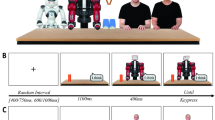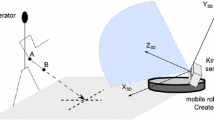Abstract
For solving tasks cooperatively in close interaction with humans, robots need to have timely updated spatial representations. However, perceptual information about the current position of interaction partners is often late. If robots could anticipate the targets of upcoming manual actions, such as pointing gestures, they would have more time to physically react to human movements and could consider prospective space allocations in their planning.
Many findings support a close eye-hand coordination in humans which could be used to predict gestures by observing eye gaze. However, effects vary strongly with the context of the interaction. We collect evidence of eye-hand coordination in a natural route planning scenario in which two agents interact over a map on a table. In particular, we are interested if fixations can predict pointing targets and how target distances affect the interlocutor’s pointing behavior. We present an automatic method combining marker tracking and 3D modeling that provides eye and gesture measurements in real-time.
Access this chapter
Tax calculation will be finalised at checkout
Purchases are for personal use only
Preview
Unable to display preview. Download preview PDF.
Similar content being viewed by others
References
Abrams, R.A., Meyer, D.E., Kornblum, S.: Eye-hand coordination: Oculomotor control in rapid aimed limb movements. Journal of Experimental Psychology: Human Perception and Performance 16(2), 248–267 (1990)
Antonelli, M., Chinellato, E., del Pobil, A.P.: Implicit mapping of the peripersonal space of a humanoid robot. In: IEEE Symposium on Computational Intelligence, Cognitive Algorithms, Mind, and Brain, vol. 3, pp. 1–8. IEEE (2011)
Berti, A., Frassinetti, F.: When far becomes near: Remapping of space by tool use. Journal of Cognitive Neuroscience 12(3), 415–420 (2000)
Biguer, B., Jeannerod, M., Prablanc, C.: The coordination of eye, head, and arm movements during reaching at a single visual target. Experimental Brain Research 46(2), 301–304 (1982)
Breazeal, C., Kidd, C.D., Thomaz, A.L., Hoffman, G., Berlin, M.: Effects of nonverbal communication on efficiency and robustness in human-robot teamwork. In: International Conference on Intelligent Robots and Systems (IROS 2005), pp. 708–713. IEEE (2005)
Carello, C., Grosofsky, A.: Visually perceiving what is reachable. Ecological Psychology 1(1), 27–54 (1989)
Farnè, A., Làdavas, E.: Auditory peripersonal space in humans. Journal of Cognitive Neuroscience 14(7), 1030–1043 (2002)
Green, A., Hüttenrauch, H.: Making a case for spatial prompting in human-robot communication. In: Language Resources and Evaluation (Workshop on Multimodal Corpora: From multimodal behavior theories to usable models) (2006)
Hadjidimitrakis, K., Breveglieri, R., Bosco, A., Fattori, P.: Three-dimensional eye position signals shape both peripersonal space and arm movement activity in the medial posterior parietal cortex. Frontiers in Integrative Neuroscience 6(37) (2012)
Holmes, N.P., Spence, C.: The body schema and the multisensory representation(s) of peripersonal space. Cognitive Processing 5(2), 94–105 (2004)
Holthaus, P., Pitsch, K., Wachsmuth, S.: How can i help? spatial attention strategies for a receptionist robot. International Journal of Social Robots 3, 383–393 (2011)
Holthaus, P., Wachsmuth, S.: Active peripersonal space for more intuitive hri. In: International Conference on Humanoid Robots, pp. 508–513. IEEE RAS, Osaka (2012)
Hüttenrauch, H., Eklundh, K., Green, A., Topp, E.: Investigating Spatial Relationships in Human-Robot Interaction. In: 2006 IEEE/RSJ International Conference on Intelligent Robots and Systems, pp. 5052–5059. IEEE, Beijing (2006)
Kendon, A.: Conducting interaction: Patterns of behavior in focused encounters, vol. 7. CUP Archive (1990)
Làdavas, E.: Functional and dynamic properties of visual peripersonal space. Trends in Cognitive Sciences 6(1), 17–22 (2002)
Mark, L., Nemeth, K., Gardner, D.: Postural dynamics and the preferred critical boundary for visually guided reaching. Journal of Experimental Psychology 23(5), 1365–1379 (1997)
Mumm, J., Mutlu, B.: Human-robot proxemics. In: Proceedings of the 6th International Conference on Human-Robot Interaction, HRI 2011, p. 331. ACM Press, New York (2011)
Neggers, S., Bekkering, H.: Ocular gaze is anchored to the target of an ongoing pointing movement. Journal of Neurophysiology 83(2), 639–651 (2000)
Nguyen, N., Wachsmuth, I.: From body space to interaction space-modeling spatial cooperation for virtual humans. In: 10th International Conference on Autonomous Agents and Multiagent Systems, pp. 1047–1054. International Foundation for Autonomous Agents and Multiagent Systems, Taipei (2011)
Nguyen, N., Wachsmuth, I.: A computational model of cooperative spatial behaviour for virtual humans. In: Representing Space in Cognition: Interrelations of Behaviour, Language, and Formal Models, pp. 147–168. Oxford University Press (2013)
Pfeiffer, T.: Understanding Multimodal Deixis with Gaze and Gesture in Conversational Interfaces. Shaker Verlag, Aachen (2011)
Pfeiffer, T.: Interaction between speech and gesture: Strategies for pointing to distant objects. In: Efthimiou, E., Kouroupetroglou, G., Fotinea, S.-E. (eds.) GW 2011. LNCS, vol. 7206, pp. 238–249. Springer, Heidelberg (2012)
Pfeiffer, T., Renner, P.: Eyesee3d: A low-cost approach for analyzing mobile 3d eye tracking data using computer vision and augmented reality technology. In: Proceedings of the Symposium on Eye Tracking Research and Applications, pp. 195–202. ACM (2014)
Prablanc, C., Echallier, J., Komilis, E., Jeannerod, M.: Optimal response of eye and hand motor systems in pointing at a visual target. Biological Cybernetics 124, 113–124 (1979)
Previc, F.H.: Functional specialization in the lower and upper visual fields in humans: Its ecological origins and neurophysiological implications. Behavioral and Brain Sciences 13, 519–542 (1990)
Rizzolatti, G., Scandolara, C., Matelli, M., Gentilucci, M.: Afferent properties of periarcuate neurons in macaque monkeys. Behavioural Brain Research 2(2), 147–163 (1981)
Staudte, M., Crocker, M.W.: Visual attention in spoken human-robot interaction. In: Proceedings of the 4th ACM/IEEE International Conference on Human Robot Interaction, HRI 2009, p. 77. ACM Press, New York (2009)
Velichkovsky, B., Sprenger, A., Pomplun, M.: Auf dem Weg zur Blickmaus: Die Beeinflussung der Fixationsdauer durch kognitive und kommunikative Aufgaben. In: Software-Ergonomie 1997, pp. 317–327. Springer (1997)
Viola, P., Jones, M.J.: Robust real-time face detection. International Journal of Computer Vision 57(2), 137–154 (2004)
Author information
Authors and Affiliations
Editor information
Editors and Affiliations
Rights and permissions
Copyright information
© 2014 Springer International Publishing Switzerland
About this paper
Cite this paper
Renner, P., Pfeiffer, T., Wachsmuth, I. (2014). Spatial References with Gaze and Pointing in Shared Space of Humans and Robots. In: Freksa, C., Nebel, B., Hegarty, M., Barkowsky, T. (eds) Spatial Cognition IX. Spatial Cognition 2014. Lecture Notes in Computer Science(), vol 8684. Springer, Cham. https://doi.org/10.1007/978-3-319-11215-2_9
Download citation
DOI: https://doi.org/10.1007/978-3-319-11215-2_9
Publisher Name: Springer, Cham
Print ISBN: 978-3-319-11214-5
Online ISBN: 978-3-319-11215-2
eBook Packages: Computer ScienceComputer Science (R0)




